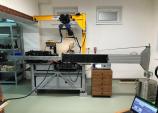Name of the standard: National Standard of Torque EZMS 10 N.m
Code designation: ECM 150-9/21-066
Year of promulgation: 2021
Department: section 8011 CMI LPM Prague
Guarantor: Ing. Lukáš Vavrečka, Ph.D.
Number of CMC lines provided: 1
| Mode | Scope | Uncertainty (k = 2) |
| Load sense right-handed | 0,2 N·m – 10 N·m | 9·10-5 |
| Load sense left-handed | 0,2 N·m – 10 N·m | 9·10-5 |
The National Standard of Torque EZMS 10 N.m is a compact device with direct loading, which consists of two systems of load bodies (one for the right-hand sense of load moment and the other for the left-hand sense), a moment arm and an air bearing. The load cells together with the torque arm implement a torque unit in the range of 0,2 N-m to 10 N-m. The reference device includes electrical power and control circuits to control the electric motors of the load cell systems and to compensate for the deformation of the calibrated transducer.
The critical parts of the reference device that define the unit of moment of force are the load cells and the moment arm. The unit of moment of force is defined as the product of the force effect of the earth's gravitational field on the load bodies of a given mass and the length of the moment arm. Correction for the buoyancy of the ambient air is made when the load bodies are just loaded.
The National Standard of Torque EZMS 10 N.m consists of the following parts:
- A system of load cells for right-hand sense loading,
- the left-hand load cell system,
- the moment of force arm,
- air bearing,
- the machine frame,
- drive motors,
- electrical switchgear,
- control panel,
- portable 1st order torque standard.
Basic metrological characteristics:
The torque standard is designed for calibration of torque standard sensors in the range of 0.2 N-m to 10 N-m under right-hand and left-hand torque loading. The best measurement capability of the standard is Wtsm = 0.009 % of the measured torque value. The best measurement capability of the standard is determined according to EURAMET/cg-14/v.02 as the expanded uncertainty of the calibration of the standard with an expansion factor of k=2, corresponding to a probability of coverage for a normal distribution of P=95 %.
Where stands for:
M | ...........…. | the moment of force generated by the standard, |
m | ...........…. | the weight of the load bodies, |
g | ...........…. | the gravitational acceleration at the location of the load bodies, |
| l | ............... | length of the moment arm |
ρvzd | ...........…. | air density at the location of the load bodies, |
ρZT | ...........…. | density of load bodies. |



